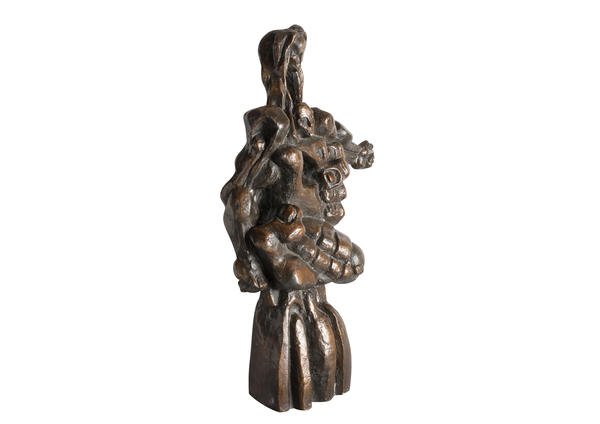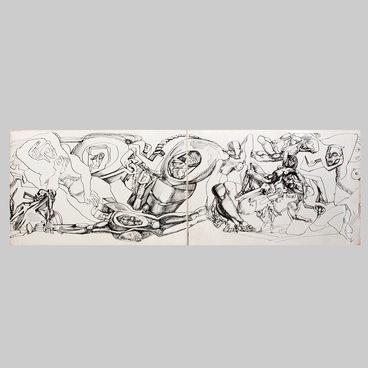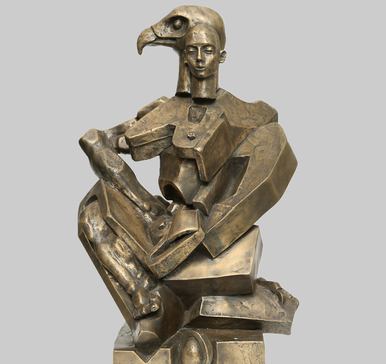In the showcase, there is a sculpture by Ernst Neizvestny The Hand of Hell, created by him in 1971. The sculpture is cast from bronze, which is patinated - artificially aged. Even in ancient China, patina was considered an important category of aesthetics for bronze products. Back then, objects made out of bronze were buried for several months in the ground so that the necessary shade appeared. Now, to give a noble shade of antiquity, bronze objects are treated with nitric acid, and after a violent reaction, a dark film appears on the surface, creating the impression of antiquity.
The hand is one of Ernst Neizvestny’s favorite symbols. The author uses the hand in his works when he wants to focus one’s attention on the freedom of human choice: the hand creates, and it destroys. But in this sculpture, it has a different role - restraining. The hand is perceived as a factor of destructiveness, an obstacle to the freedom of personal self-realization.
This work is one of the sculptures from Dante series. The works of the great Italian writer, poet and playwriter Dante Alighieri were reread many times by the sculptor, and the masterfully painted images created by Dante inspired and prompted the motives of future works. It happened this time too: The Hand of Hell is the sculptor’s reaction to the description of the nine circles of hell in Dante’s Divine Comedy.
Dante Alighieri, born in Florence in the middle of the 13th century, had the name Durante from birth. He is considered one of those who stood at the origins of the literary Italian language, in his works questions of morality and faith in God are raised. In Divine Comedy, we are talking about the mortality of man’s earthly life and afterlife.
The Hand of Hell is probably a symbol uniting the nine circles of hell described by Dante in the Divine Comedy and warning about the trials that await sinners. As if it is clenching in a fist all who it managed to reach out to.
Ernst Neizvestny created illustrations not only for the Divine Comedy, but also for the collection of small works of the Italian genius, published in the Soviet Union in the 60s of the last century.
The hand is one of Ernst Neizvestny’s favorite symbols. The author uses the hand in his works when he wants to focus one’s attention on the freedom of human choice: the hand creates, and it destroys. But in this sculpture, it has a different role - restraining. The hand is perceived as a factor of destructiveness, an obstacle to the freedom of personal self-realization.
This work is one of the sculptures from Dante series. The works of the great Italian writer, poet and playwriter Dante Alighieri were reread many times by the sculptor, and the masterfully painted images created by Dante inspired and prompted the motives of future works. It happened this time too: The Hand of Hell is the sculptor’s reaction to the description of the nine circles of hell in Dante’s Divine Comedy.
Dante Alighieri, born in Florence in the middle of the 13th century, had the name Durante from birth. He is considered one of those who stood at the origins of the literary Italian language, in his works questions of morality and faith in God are raised. In Divine Comedy, we are talking about the mortality of man’s earthly life and afterlife.
The Hand of Hell is probably a symbol uniting the nine circles of hell described by Dante in the Divine Comedy and warning about the trials that await sinners. As if it is clenching in a fist all who it managed to reach out to.
Ernst Neizvestny created illustrations not only for the Divine Comedy, but also for the collection of small works of the Italian genius, published in the Soviet Union in the 60s of the last century.




